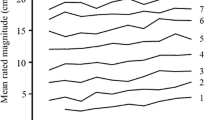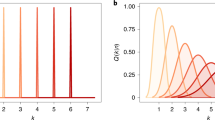Abstract
This study examined the generality of the result that linear or logarithmic functions best describe the relationship between numerical stimuli and people’s judgments about those stimuli. In Experiment 1, one group of participants was told that 2 was a perfect example of category x and 6 was a perfect example of category y; another group was told the same about 6 and 18. The participants then rated how well logarithmically spaced numbers matched the category x number. Exponential and logarithmic functions best fit the data of individual participants who did the “2 vs. 6” task; power functions did the same in the “6 vs. 18” task. When participants’ data were averaged, a logarithmic function was the best fit for the ratings produced by the “2 vs. 6” task; power and exponential functions were the best fits for the ratings produced by the “6 vs. 18” task. In Experiment 2, two groups of participants were given similar rules about two numbers (2 vs. 4 or 4 vs. 6) and then rated how well linearly spaced numbers matched the category x number. For both tasks, most individuals’ ratings best fit a linear function. When the data were averaged, though, a logarithmic function was the best fit for the ratings produced by both tasks. The results highlight the importance of presenting individuals’ data and suggest that global and local numerical contexts influence people’s judgments about the numbers. Stimulus generalization may be a mechanism by which the local influence occurs.












Similar content being viewed by others
Notes
Exactly what represents (a verb) and representation (a noun) mean is unclear; see Greco (1995) for a discussion of the many meanings of these terms. In cognitive psychology, representation (O) refers to hypothetical physiological or computational mechanisms. The characteristics of a representation are inferred from responses (R) to stimuli (S). Or we can use the terms represents and representation simply as shorthand for the production of—or in reference to—the functional relation between real numbers (S) and judgments (R) based on those numbers. That is the usage we adopt here.
References
Almeida, A., Arantes, J., & Machado, A. (2007). Numerosity discrimination in preschool children. Journal of the Experimental Analysis of Behavior, 88(3), 339–354. https://doi.org/10.1901/jeab.2007.88-339.
Anderson, R. B., & Tweney, R. D. (1997). Artifactual power curves in forgetting. Memory & Cognition, 25(5), 724–730. https://doi.org/10.3758/BF03211315.
Banks, W. P., & Coleman, M. J. (1981). Two subjective scales of number. Perception & Psychophysics, 29(2), 95–105. https://doi.org/10.3758/BF03207272.
Barlow, D. H., & Nock, M. K. (2009). Why can’t we be more idiographic in our research? Perspectives in Psychological Science, 4(1), 19–21. https://doi.org/10.1111/j.1745-6924.2009.01088.x.
Barth, H. C., & Paladino, A. M. (2011). The development of numerical estimation: Evidence against a representational shift. Developmental Science, 14(1), 125–135. https://doi.org/10.1111/j.1467-7687.2010.00962.x.
Barth, H., Slusser, E., Cohen, D., & Paladino, A. (2011). A sense of proportion: Commentary on Opfer, Siegler, and Young. Developmental Science, 14(5), 1205–1206. https://doi.org/10.1111/j.1467-7687.2011.01081.x.
Barth, H., Slusser, E., Kanjlia, S., Garcia, J., Taggart, J., & Chase, E. (2015). How feedback improves children’s numerical estimation. Psychonomic Bulletin & Review, 23(4), 1198–1205. https://doi.org/10.3758/s13423-015-0984-3.
Berteletti, I., Lucangeli, D., Piazza, M., Dehaene, S., & Zorzi, M. (2010). Numerical estimation in preschoolers. Developmental Psychology, 46(2), 545–551. https://doi.org/10.1037/a0017887.
Bouwmeester, S., & Verkoeijen, P. P. J. L. (2012). Multiple representations in number line estimation: A developmental shift or classes of representations? Cognition & Instruction, 30(3), 246–260. https://doi.org/10.1080/07370008.2012.689384.
Butterworth, B., Gallistel, C. R., & Vallortigara, G. (Eds.). (2018). The origins of numerical abilities [Discussion meeting issue]. Philosophical Transactions of the Royal Society B, 373(1740). https://doi.org/10.1098/rstb.2016.0507.
Carvalho, M. P., Machado, A., & Tonneau, F. (2016). Learning in the temporal bisection task: Relative or absolute? Journal of Experimental Psychology: Animal Learning & Cognition, 42(1), 67–81. https://doi.org/10.1037/xan0000089.
Cohen, D. J., & Sarnecka, B. (2014). Children’s number-line estimation shows development of measurement skills (not number representations). Developmental Psychology, 50(6), 1640–1652. https://doi.org/10.1037/a0035901.
Conaway, N., & Kurtz, K. (2017). Similar to the category, but not the exemplars: A study of generalization. Psychonomic Bulletin & Review, 24(4), 1312–1323. https://doi.org/10.3758/s13423-016-1208-1.
Cordes, S., Gelman, R., Gallistel, C. R., & Whalen, J. (2001). Variability signature distinguish verbal from nonverbal counting for both large and small numbers. Psychonomic Bulletin & Review, 8(4), 698–707. https://doi.org/10.3758/BF03196206.
Church, R. M., & Deluty, M. Z. (1977). Bisection of temporal intervals. Journal of Experimental Psychology: Animal Behavior Processes, 3(3), 216–228. https://doi.org/10.1037/0097-7403.3.3.216.
Defever, E., Reynvoet, B., & Gebuis, T. (2013). Task- and age-dependent effects of visual stimulus properties on children’s explicit numerosity judgments. Journal of Experimental Child Psychology, 116(2), 216–233. https://doi.org/10.1016/j.jecp.2013.04.006.
Dehaene, S. (1997). The number sense: How the mind creates mathematics. Oxford University Press.
Dehaene, S., & Changeux, J.-P. (1993). Development of elementary numerical abilities: A neuronal model. Journal of Cognitive Neuroscience, 5(4), 390–407. https://doi.org/10.1162/jocn.1993.5.4.390.
Dehaene, S., Izard, V., Spelke, E., & Pica, P. (2008). Log or linear? Distinct intuitions of the numbers scale in Western and Amazonian indigene cultures. Science, 320(5880), 1217–1220. https://doi.org/10.1126/science.1156540.
Dehaene, S., & Mehler, J. (1992). Cross-linguistic regularities in the frequency of number words. Cognition, 43(1), 1–29. https://doi.org/10.1016/0010-0277(92)90030-L.
Ditz, H. M., & Nieder, A. (2016). Numerosity representations in crows obey the Weber-Fechner law. Proceedings of the Royal Society B, 283(1827), 20160083. https://doi.org/10.1098/rspb.2016.0083.
Estes, W. K., & Maddox, W. T. (2005). Risks of drawing inferences about cognitive processes from model fits to individual versus average performance. Psychonomic Bulletin & Review, 12(3), 403–408. https://doi.org/10.3758/BF03193784.
Feigenson, L., Dehaene, S., & Spelke, E. S. (2004). Core systems of number. Trends in Cognitive Sciences, 8(7), 307–314. https://doi.org/10.1016/j.tics.2004.05.002.
Fetterman, J. G. (1993). Numerosity discrimination: Both time and number matter. Journal of Experimental Psychology: Animal Behavior Processes, 19(2), 149–164. https://doi.org/10.1037/0097-7403.19.2.149.
Fischer, M. H., & Campen, H. (2009). Pointing to numbers and grasping magnitudes. Experimental Brain Research, 192(1), 149–153. https://doi.org/10.1007/s00221-008-1622-3.
Franklin, M. S., Jonides, J., & Smith, E. E. (2009). Processing of order information for numbers and months. Memory & Cognition, 37(5), 644–654. https://doi.org/10.3758/MC.37.5.644.
Gallistel, C. R. (1990). The organization of learning. MIT Press.
Gallistel, C. R. (2017). Learning and representation. In J. H. Byrne (Ed.), Learning and memory: A comprehensive reference (2nd ed., pp. 141–154). Elsevier.
Ghirlanda, S., & Enquist, M. (2007). How training and testing histories affect generalization: A test of simple neural networks. Philosophical Transactions of the Royal Society B, 362(1479), 449–454. https://doi.org/10.1098/rstb.2006.1972.
Guttman, H., & Kalish, H. I. (1956). Discriminability and stimulus generalization. Journal of Experimental Psychology, 51(1), 79–88. https://doi.org/10.1037/h0046219.
Greco, A. (1995). The concept of representation in psychology. Cognitive Systems, 4, 247–256.
Normand, M. P. (2016). Less is more: Psychologists can learn more by studying fewer people. Frontiers in Psychology, 7, Article 934. https://doi.org/10.3389/fpsyg.2016.00934.
Núñez, R. E. (2017). Is there really an evolved capacity for number? Trends in Cognitive Sciences, 21(6), 409–424. https://doi.org/10.1016/j.tics.2017.03.005.
Núñez, R., Cooperrider, K., & Wassman, J. (2012). Number concepts without number lines in an indigenous group of Papua New Guinea. PLoS One, 7(4), e35662. https://doi.org/10.1371/journal.pone.0035662.
Opfer, J. E. (n.d.). Analyzing the number-line task: A tutorial. Retrieved January 7, 2021 from https://www.yumpu.com/en/document/read/8340326/analyzing-the-number-line-task-a-tutorial-carnegie-mellon
Opfer, J. E., & DeVries, J. M. (2008). Representational change and magnitude estimation: Why young children can make more accurate salary comparisons than adults. Cognition, 108(3), 843–849. https://doi.org/10.1016/j.cognition.2008.05.003.
Opfer, J. E., & Siegler, R. S. (2007). Representational change and children’s numerical estimation. Cognitive Psychology, 55(3), 169–195. https://doi.org/10.1016/j/cogpsych.2006.09.002.
Parducci, A. (1965). Category judgment: A range-frequency model. Psychological Review, 72(6), 407–418. https://doi.org/10.1037/h0022602.
Povinelli, D. J. (2000). Folk physics for apes: The chimpanzee’s theory of how the world works. Oxford University Press.
Ramani, G. B., & Siegler, R. S. (2008). Promoting broad and stable improvements in low-income children’s numerical knowledge through playing number board games. Child Development, 79(2), 375–394. https://doi.org/10.1111/j.1467-8624.2007.01131.x.
Sauce, B., & Matzel, L. D. (2013). The causes of variation in learning and behavior: Why individual differences matter. Frontiers in Psychology, 4, Article 395. https://doi.org/10.3389/fpsyg.2013.00395.
Schneider, B., Parker, S., Ostrosky, D., Stein, D., & Kanow, G. (1974). A scale for the psychological magnitude of number. Perception & Psychophysics, 16(1), 43–46. https://doi.org/10.3758/BF03203247.
Schneider, M., Thompson, C. A., & Rittle-Johnson, B. (2018). Associations of magnitude comparison and number line estimation with mathematical competence: A comparative review. In P. Lemaire (Ed.), Cognitive development from a strategy perspective: A festschrift for Robert Siegler (pp. 100–119). Routledge.
Sella, F., Berteletti, I., Lucangeli, D., & Zorzi, M. (2017). Preschool children use space, rather than counting, to infer the numerical magnitude of digits: Evidence for a spatial mapping principle. Cognition, 158, 56–67. https://doi.org/10.1016/j.cognition.2016.10.010.
Shepard, R. N. (1987). Toward a universal law of generalization for psychological science. Science, 237(4820), 1317–1323. https://doi.org/10.1126/science.3629243.
Sidman, M. (1960). Tactics of scientific research: Evaluating experimental data in psychology. Basic Books.
Siegler, R. S., & Booth, J. L. (2004). Development of numerical estimation in young children. Child Development, 75(2), 428–444. https://doi.org/10.1111/j.1467-8624.2004.00684.x.
Siegler, R. S., & Opfer, J. E. (2003). The development of numerical estimation: Evidence for multiple representations of numerical quantity. Psychological Science, 14(3), 237–243. https://doi.org/10.1111/1467-9280.02438.
Skinner, B. F. (1977). Why I am not a cognitive psychologist. Behaviorism, 5(2), 1–10.
Smets, K., Moors, P., & Reynvoet, B. (2016). Effects of presentation type and visual control in numerosity discrimination: Implications for number processing? Frontiers in Psychology, 7, Article 66. https://doi.org/10.3389/fpsyg.2016.00066.
Stevens, S. S. (1962). The surprising simplicity of sensory metrics. American Psychologist, 17(1), 29–39. https://doi.org/10.1037/h0045795.
Sullivan, J., Juhasz, B., Slattery, T., & Barth, H. (2011). Adults’ number-line estimation strategies: Evidence from eye movements. Psychonomic Bulletin & Review, 18(3), 557–563. https://doi.org/10.3758/s13423-011-0081-1.
Tan, L., & Grace, R. (2010). Discrimination and representation of relative numerosity in a bisection task by pigeons. Learning & Behavior, 38(4), 408–417. https://doi.org/10.3758/LB.38.4.408.
Tao, T., Wyer Jr., R. S., & Zheng, Y. (2017). The role of categorization and scale endpoint comparisons in numerical information processing. A two-process model. Journal of Experimental Psychology: General, 146(3), 409–427. https://doi.org/10.1037/xge0000266.
van Hoogmoed, A. H., & Kroesbergen, E. H. (2018). On the difference between numerosity processing and number processing. Frontiers in Psychology, 9, 1650. https://doi.org/10.3389/fpsyg.2018.01650.
Zhang, J., & Wang, H. (2005). The effect of external representations on numeric tasks. Quarterly Journal of Experimental Psychology A, 58(5), 817–838. https://doi.org/10.1080/02724980443000340.
Acknowledgements
We thank Armando Machado for this helpful comments and insightful discussions related to an earlier version of this manuscript.
Availability of data and material
All data from all individuals are included in the manuscript.
Code availability
Not applicable.
Funding
The authors have no funding to report.
Author information
Authors and Affiliations
Corresponding author
Ethics declarations
Conflicts of interest
The authors have no known conflict of interest to disclose.
Ethics approval/Consent to participate
The research described in the manuscript was approved by the University’s Institutional Review Board (IRB) and conforms to the United States federal government’s guidelines for the use of humans in research.
Consent for publication
Not applicable
Additional information
Publisher’s Note
Springer Nature remains neutral with regard to jurisdictional claims in published maps and institutional affiliations.
Rights and permissions
About this article
Cite this article
Silva, F.J., Silva, P.N. & Silva, K.M. Judging Numbers: Global and Local Contextual Effects in Individual and Group Data. Psychol Rec 72, 285–304 (2022). https://doi.org/10.1007/s40732-021-00467-w
Accepted:
Published:
Issue Date:
DOI: https://doi.org/10.1007/s40732-021-00467-w




